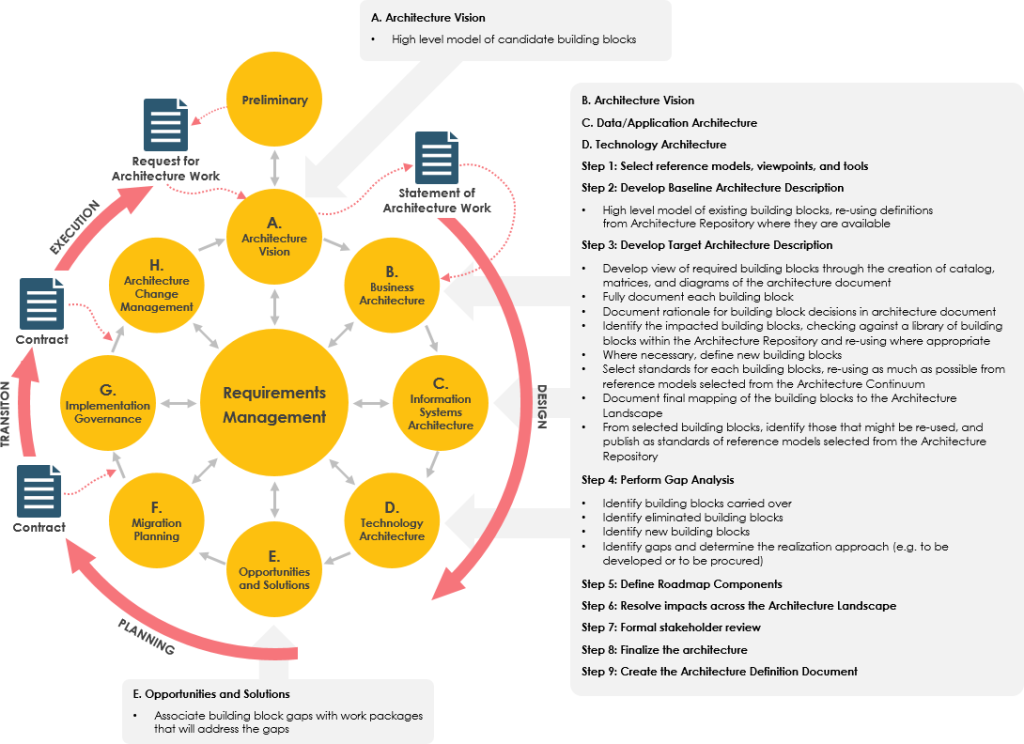Welcome to the next part of our TOGAF Foundation series. If you want to master this enterprise architecture framework, understanding the Architecture Development Method (ADM) is essential.
The ADM is the core engine of TOGAF—the structured yet flexible process that guides organizations from strategy to execution. In this article, we’ll break down the ADM’s structure, phases, and guiding principles so you can apply it effectively in real-world enterprise architecture projects.
What is the ADM and Why Is It Important?
The Architecture Development Method is a step-by-step, iterative approach to developing and managing enterprise architecture. It ensures that architectural work is aligned with business strategy, consistent across teams, and adaptable to change.
Key Roles of the ADM:
- Structures the Process – Provides a clear roadmap, reducing the complexity of large-scale architecture initiatives.
- Ensures Consistency – Establishes a repeatable process that aligns with an organization’s architecture principles and governance.
- Links Strategy to Execution – Bridges high-level business goals with practical IT solutions and technology roadmaps.
The 9-Phase ADM Cycle: High-Level Overview
The ADM is cyclical, consisting of a Preliminary Phase, eight main phases (A–H), and a central Requirements Management function that operates throughout the cycle.

Preliminary Phase – Setting the Stage
Before the main cycle begins, this phase prepares the organization by:
- Establishing the Architecture Capability
- Defining governance principles and frameworks
- Aligning stakeholders on the EA approach
Phase A: Architecture Vision – Defining the Destination
- Clarify business goals, scope, and constraints
- Gain stakeholder buy-in for the architecture work
- Produce the Statement of Architecture Work
Phases B, C, D – Designing the Architecture
Phase B: Business Architecture – Models the business strategy, governance, organization, and key business processes.
- Phase C: Information Systems Architectures –
- Data Architecture: Defines the structure and management of enterprise data.
- Application Architecture: Outlines the major applications and their interactions.
- Phase D: Technology Architecture – Defines the infrastructure, platforms, and technology services.
Phases E, F – Planning the Transition
- Phase E: Opportunities & Solutions – Identifies major implementation projects and develops a high-level Architecture Roadmap.
- Phase F: Migration Planning – Prioritizes projects, sequences transitions, and produces a detailed implementation plan.
Phases G, H – Governance and Evolution
- Phase G: Implementation Governance – Monitors and ensures solutions are implemented in line with the target architecture.
- Phase H: Architecture Change Management – Maintains the relevance of the architecture as business and technology needs evolve.
Requirements Management – The Central Hub
- Operates continuously across all phases
- Tracks, validates, and ensures requirements are addressed throughout the ADM cycle
Why the ADM Works: Flexibility & Iteration
The ADM is not a strict, linear process—it is iterative and adaptable:
- Iterative – You can loop back to earlier phases as needed to refine the architecture.
- Customizable – The ADM can integrate with Agile, Waterfall, or hybrid project management methods.
- Domain-Focused – You can tailor it to address only one architecture domain (e.g., data or technology) when needed.
By mastering the ADM, you gain the blueprint for turning enterprise strategy into actionable, measurable results. In our next article, we’ll dive into Phase A: Architecture Vision and see how to set a strong foundation for the entire cycle.